What is RFID? What role does RFID play in IoT devices?
Radio-Frequency Identification (RFID) is a popular technology in production to identify, record and control moving objects.
RFID is very useful in identifying objects and even people. For example, it is possible to find an RFID chip in the latest biometric passport.
RFID is also used in Industrial Internet of Things (IIoT) to track large objects such as boxes or pallets (inventory sheets). However, in this article, the role of RFID in IoT will be described in much more detail than in industrial goods.
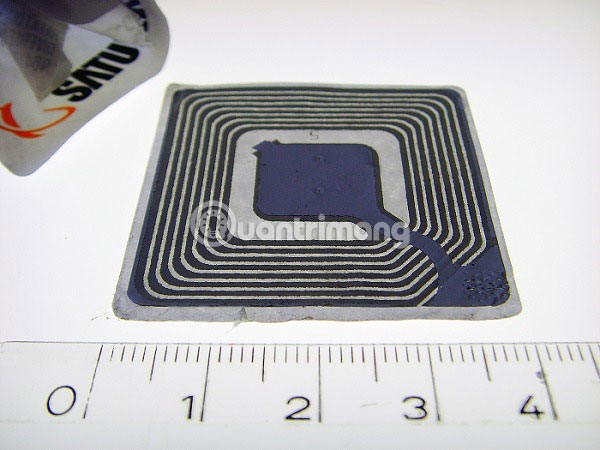
Learn about Radio-Frequency Identification (RFID) technology
- What is RFID? How does it work?
- 1. RFID tag
- 2. RFID reader device
- 3. RFID Application / Software
- RFID applications in IoT devices
- Smart home
- Health care
- Smart traffic
What is RFID? How does it work?
Technology that makes RFID has been present for at least 5 decades. This technology uses radio waves and electromagnetic fields to transmit data, as well as identify objects. Basically, an RFID system consists of three components:
1. RFID tag
RFID tags often appear in product bar codes at supermarkets. However, these are just "passive" RFID tags that are easy to activate, because they do not have their own power supply.
In contrast, 'active' RFID tags may include a microchip or antenna and sensors. For example, a fresh fish purchased at a store can be fitted with a thermal sensor in an RFID tag to determine when a perishable product is overdue.
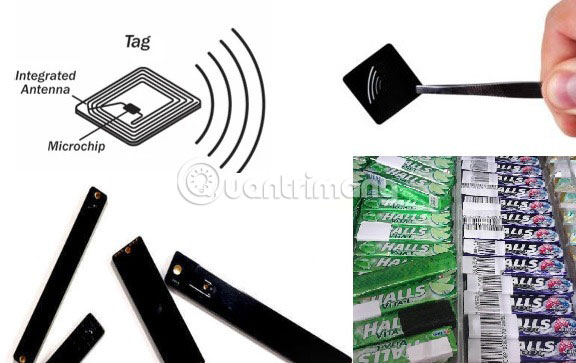
2. RFID reader device
RFID reader is a device that uses radio waves to identify RFID tags and transfer the status of this tag to software or RFID applications. RFID readers can be handheld, USB-controlled or even Bluetooth-enabled.
Note : Contrary to popular belief, barcode scanners are not RFID readers unless they have an RFID module. However, RFID readers can certainly read barcodes.
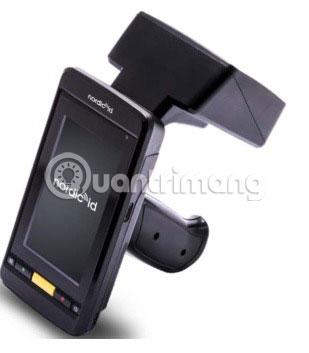
3. RFID Application / Software
There is usually a software or even a mobile application to control and monitor RFID tags. RFID Application / Software can use Bluetooth technology or Beacon to communicate with RFID reader devices.
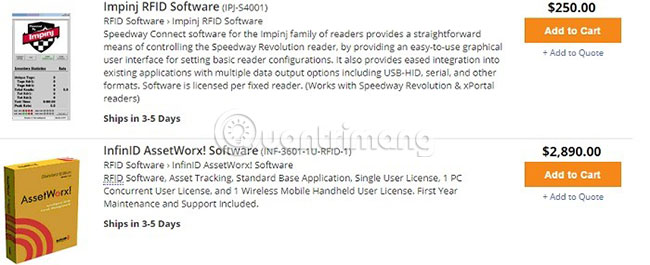
Below is a simple diagram of an RFID system along with a mobile application. This diagram shows various simple applications including hospital beds, airplanes, food, cars and many more connected devices via RFID tags.
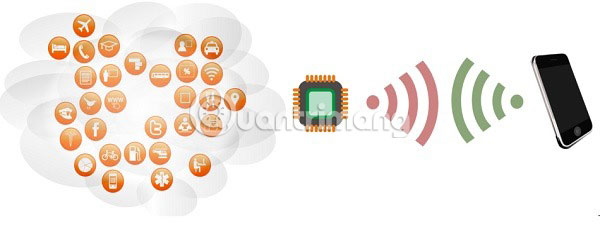
RFID applications in IoT devices
In IoT, RFID is used together with camera, GPS, smart sensors to locate and identify objects.
Smart home
RFID is a economical way to make household items more 'smart'. Attaching RFID chips on common objects does not take time or money. Do you have smart clothes? With an intelligent washing machine that can read RFID labels, you can control the washing cycle and dry it.
One of RFID's commercial applications is Nest Tag, a keychain for $ 25 (580,000 VND) that can activate Google's Nest alarm system.
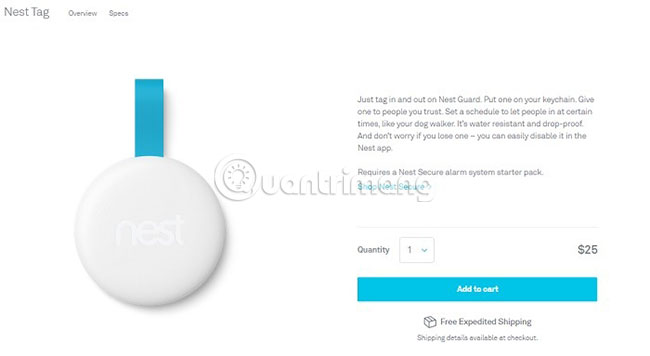
Health care
Their health data is automatically recorded and updated in the EHR system. A tool for EHR reporting could also be used to improve data management. Some concerns about infringement of privacy may be raised, but HIPAA Privacy rule provides standards to safeguard patient information. However, this also raises concerns about the body's infringement of privacy.
Smart traffic
Smart vehicles in different cities around the world use RFID tags to control traffic. RFID tags can read passenger data as well as keep traffic system warnings up to date.
RFID tag has some problems in practical application. For example, they are susceptible to interference and can cause conflicts between objects. Moreover, RFID networks are currently vulnerable to IoT security issues. There have been a number of recorded DDoS and eavesdropping attacks.
It must be said that the large and low-cost range of RFID systems has made them an ideal proposition for both consumers and IIoT.
You should read it
- 8 technology-related obsessions of the decade
- Wireless technology for managing people and objects - Future social networks?
- Errors on mobile applications allow hackers to control LG devices
- What role does UHQ Upscaler play on Samsung devices?
- How to secure Bluetooth devices
- Six tips for adding wireless devices to your work environment
- Google released Android Things 1.0 for IoT devices
- 11 ways to keep IoT devices safe
May be interested
- How to use Lutris to play Blu-Ray on Linux
 now, users can play blu-ray discs on linux systems only by using windows software via wine. however, this process can cause many headaches and that's where lutris plays its role.
now, users can play blu-ray discs on linux systems only by using windows software via wine. however, this process can cause many headaches and that's where lutris plays its role. - What are chips, chipsets, and processors? What role do they play in the computer system?
 what are chips, chipsets, and processors? what role do they play in the computer system? on a computer motherboard is the appearance of a lot of different components and components. the work of the motherboard on a computer system is linked
what are chips, chipsets, and processors? what role do they play in the computer system? on a computer motherboard is the appearance of a lot of different components and components. the work of the motherboard on a computer system is linked - Genes play an important role in children exploring the world in a visual way
 genetics plays a strong role in discovering the environment visually by studying the eye movements of twins.
genetics plays a strong role in discovering the environment visually by studying the eye movements of twins. - Bowel and gastrointestinal tract play an important role in the development of type 2 diabetes
 a recent study found that the intestines and gastrointestinal tract play an important role in the development of type 2 diabetes.
a recent study found that the intestines and gastrointestinal tract play an important role in the development of type 2 diabetes. - Some common error codes on CH Play and how to fix them
 ch play (google play store) is probably an application very familiar to those of you who use the android operating system on mobile devices. although it is an application that is invested by google to develop and upgrade continuously, ch play is not immune to unexpected errors.
ch play (google play store) is probably an application very familiar to those of you who use the android operating system on mobile devices. although it is an application that is invested by google to develop and upgrade continuously, ch play is not immune to unexpected errors. - How to Add a Device to the Google Play App Store
 when you add a device to google play, you can access previously purchased apps, movies, music, books, and other content on the new device. you can add android devices very easily by simply signing in with the same google account. if you use an amazon fire tablet, you can choose from several alternatives to download the play store and access all android apps. you can't add ios (iphone, ipad) or windows devices to google play.
when you add a device to google play, you can access previously purchased apps, movies, music, books, and other content on the new device. you can add android devices very easily by simply signing in with the same google account. if you use an amazon fire tablet, you can choose from several alternatives to download the play store and access all android apps. you can't add ios (iphone, ipad) or windows devices to google play. - How to download and play The Evil Within 2 for free on PC
 download and play the evil within 2 for free on pc, a horror role-playing game combined with survival with eye-catching 3d graphics, combat visual effects and realistic sound that is highly appreciated by gamers. high.
download and play the evil within 2 for free on pc, a horror role-playing game combined with survival with eye-catching 3d graphics, combat visual effects and realistic sound that is highly appreciated by gamers. high. - What is email encryption? Why does it play an important role in email security?
 how to secure email? what is email encryption and why does it play an important role in email security?
how to secure email? what is email encryption and why does it play an important role in email security? - How to enter the code and the latest Epic War: Thrones code list
 epic war: thrones is a massively multiplayer strategy game, with unreal engine 4 bringing pc-like gaming experiences to mobile devices. players will play the role of a warlord leading his army to conquer the unknown land.
epic war: thrones is a massively multiplayer strategy game, with unreal engine 4 bringing pc-like gaming experiences to mobile devices. players will play the role of a warlord leading his army to conquer the unknown land. - How to install DNS Role in Windows Server 2012
 dns role is one of the most important services in the network containing the domain controllers environment.
dns role is one of the most important services in the network containing the domain controllers environment.










 Security vulnerabilities - basic insights
Security vulnerabilities - basic insights Build your own computer, build your desktop (P4): Install Windows and drivers
Build your own computer, build your desktop (P4): Install Windows and drivers Secedit command: generaterollback in Windows
Secedit command: generaterollback in Windows What is Hyper-Threading (Hyper-Threading)?
What is Hyper-Threading (Hyper-Threading)? Self-assemble computers, build desktop computers (P5): Refine new computers
Self-assemble computers, build desktop computers (P5): Refine new computers Secedit: import command in Windows
Secedit: import command in Windows